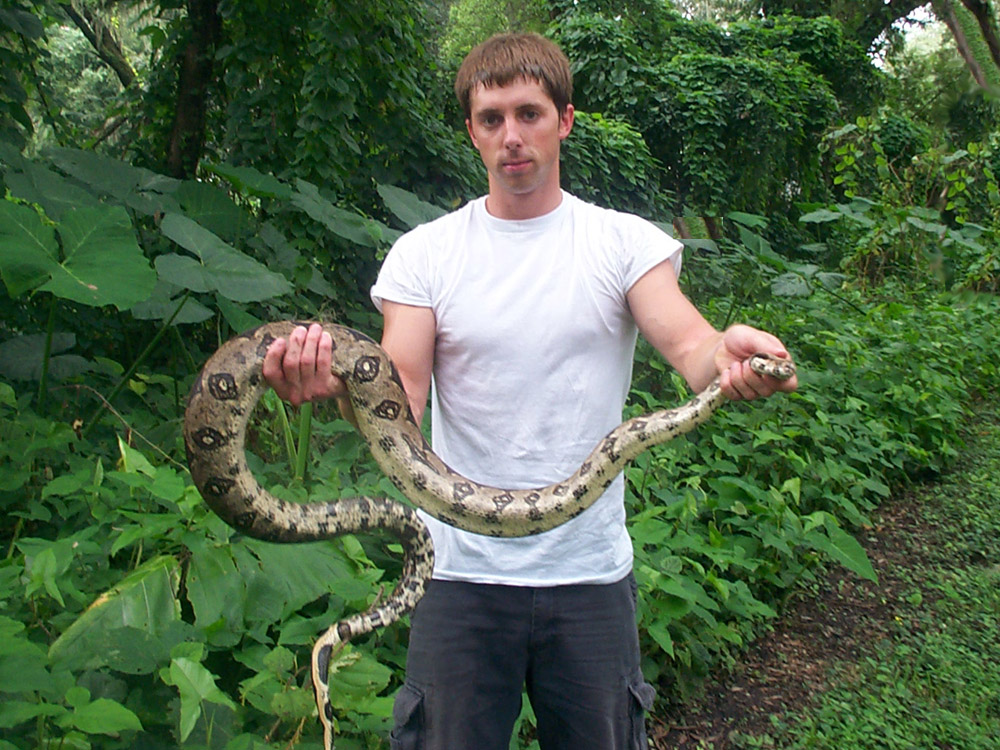|

 |
I was excited to catch this first Boa Constrictor from an old couple's garage. |
 |
DESCRIPTION: I caught this snake in my first year.
If you need snake removal in your town, click for the National Directory of
Snake Removal Companies that I've carefully compiled in every USA city.
Boa constrictors are large, heavy bodied snakes and the largest can grow up to 13 feet and weigh over 100 pounds; however, adults are normally 8 – 10 feet long. They live in the tropics of Central and South America and prefer to keep to dry land, even though they are excellent swimmers.
The color of a boa constrictor’s skin depends on its particular habitat; green, brown, red, and yellow body colors are common, with a dark pattern of blotches running over the skin. The distinctive patterns on their skin make them easy to spot.
Boas are non-poisonous, nocturnal carnivores. Young boas typically eat things like birds, mice, lizards, and anything else they can catch that will fit into their mouths. As they grow into adulthood, they catch larger animals like boars, deer, or monkeys. They eat what is abundant in their habitat.
They catch prey by striking and grabbing it with their teeth, then curl around it until it cannot breathe anymore and it dies. Boas do not chew with their teeth, but swallow their prey head first and whole.
Female boa constrictors incubate eggs inside their bodies and then give birth to live young. The newborns are usually two feet long and boas can live from 25 to 30 years in the wild.
Interesting Facts: Female boa constrictors can give birth to up to 60 live babies.
Boa constrictors have two vestigial (non-functional) hind limbs on their bellies near the tail.
Just because a bat flies at night does not mean it is safe from a boa constrictor’s jaws. Boas often hang down from tree limbs and catch bats for dinner in mid-flight.
Prey is eaten head first so the limbs lay flat so the animal is more easily swallowed.
Boa constrictors’ jaws are connected by tendons and muscles, and the lower jaw consists of two separate bones.
Running a wildlife removal business in the state of Florida gives me the chance to see all kinds of interesting snakes! Florida has about 45 species of snake, and I've seen 29 of them so far. I've always got my eye out for new species, and
I love spotting rare snakes in Florida. I also have a thing for venomous snakes - they're not too common in FL, so I always enjoy the chance to see a poisonous serpent. I really like snakes, and I've never hurt or killed one. They're an
important part of the ecosystem, and often persecuted. Still, if you don't want snakes in your house or on your property, and judging from the number of phone calls I receive regarding snake problems, you don't, then give me or a local snake
expert in your area a call, and we can remove the snakes from your property for you. I use many snake control methods - from snake traps, to snake repellents, to habitat modification, but most of all, good old-fashioned capture and removal.
If you want to learn more, please read my How To Get Rid of Snakes page.
AAAnimal Control is a privately owned wildlife removal and pest control business, located in Orlando Florida. I deal strictly with wild animals including snakes inside houses. I am not an extermination company, but a critter removal
and control specialist. The above photos are some of the many that I've taken in the field over my years of work. Please email me if
you have any questions about the above photographs, or any questions about
wildlife problems or Florida snake removal issues.
You can safely catch snakes with a special trap, which you can order by clicking this banner:

|
| |
|